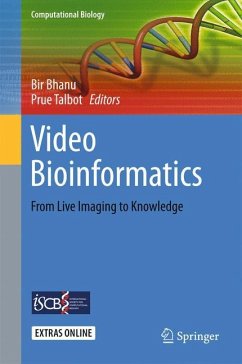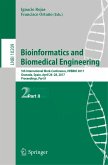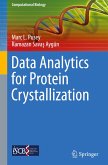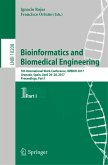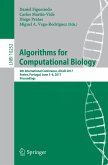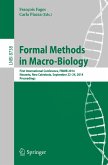This unique text presents a selection of innovative computational techniques to enable the efficient analysis of biological processes in large video sequences and databases. Features: provides a detailed introduction to the field of video bioinformatics; examines the analysis and visualization of injured brain tissue in rodent models, using magnetic resonance imaging and optical coherence tomography; discusses segmentation of stem cell colonies and analysis of individual stem cells; describes the application of commercially available software to solve problems in video bioinformatics related to stem cell behavior in vitro; reviews video bioinformatics problems in plant and fungus biology; presents a high throughput method for quantifying DNA damage in cells, and a method that uses optogenetics to regulate protein transport in cultured cells; surveys the various software tools and databases available for use with video bioinformatics problems.
The advances of live cell video imaging and high-throughput technologies for functional and chemical genomics provide unprecedented opportunities to understand how biological processes work in subcellularand multicellular systems. The interdisciplinary research field of Video Bioinformatics is defined by BirBhanu as the automated processing, analysis, understanding, data mining, visualization, query-basedretrieval/storage of biological spatiotemporal events/data and knowledge extracted from dynamic imagesand microscopic videos. Video bioinformatics attempts to provide a deeper understanding of continuousand dynamic life processes.Genome sequences alone lack spatial and temporal information, and video imaging of specific moleculesand their spatiotemporal interactions, using a range of imaging methods, are essential to understandhow genomes create cells, how cells constitute organisms, and how errant cells cause disease. The bookexamines interdisciplinary research issues and challenges with examples that deal with organismal dynamics,intercellular and tissue dynamics, intracellular dynamics, protein movement, cell signaling and softwareand databases for video bioinformatics.Topics and Features- Covers a set of biological problems, their significance, live-imaging experiments, theory andcomputational methods, quantifiable experimental results and discussion of results.- Provides automated methods for analyzing mild traumatic brain injury over time, identifying injurydynamics after neonatal hypoxia-ischemia and visualizing cortical tissue changes during seizureactivity as examples of organismal dynamics- Describes techniques for quantifying the dynamics of human embryonic stem cells with examplesof cell detection/segmentation, spreading and other dynamic behaviors which are important forcharacterizing stem cell health- Examines and quantifies dynamic processes in plant and fungal systems such as cell trafficking,growth of pollen tubes in model systems such asNeurospora Crassa and Arabidopsis- Discusses the dynamics of intracellular molecules for DNA repair and the regulation of cofilintransport using video analysis- Discusses software, system and database aspects of video bioinformatics by providing examples of5D cell tracking by FARSIGHT open source toolkit, a survey on available databases and software,biological processes for non-verbal communications and identification and retrieval of moth imagesThis unique text will be of great interest to researchers and graduate students of Electrical Engineering,Computer Science, Bioengineering, Cell Biology, Toxicology, Genetics, Genomics, Bioinformatics, ComputerVision andPattern Recognition, Medical Image Analysis, and Cell Molecular and Developmental Biology.The large number of example applications will also appeal to application scientists and engineers.Dr. Bir Bhanu is Distinguished Professor of Electrical & C omputer Engineering, Interim Chair of theDepartment of Bioengineering, Cooperative Professor of Computer Science & Engineering, and MechanicalEngineering and the Director of the Center for Research in Intelligent Systems, at the University of California,Riverside, California, USA.Dr. Prue Talbot is Professor of Cell Biology & Neuroscience and Director of the Stem Cell Center and Core atthe University of California Riverside, California, USA.
The advances of live cell video imaging and high-throughput technologies for functional and chemical genomics provide unprecedented opportunities to understand how biological processes work in subcellularand multicellular systems. The interdisciplinary research field of Video Bioinformatics is defined by BirBhanu as the automated processing, analysis, understanding, data mining, visualization, query-basedretrieval/storage of biological spatiotemporal events/data and knowledge extracted from dynamic imagesand microscopic videos. Video bioinformatics attempts to provide a deeper understanding of continuousand dynamic life processes.Genome sequences alone lack spatial and temporal information, and video imaging of specific moleculesand their spatiotemporal interactions, using a range of imaging methods, are essential to understandhow genomes create cells, how cells constitute organisms, and how errant cells cause disease. The bookexamines interdisciplinary research issues and challenges with examples that deal with organismal dynamics,intercellular and tissue dynamics, intracellular dynamics, protein movement, cell signaling and softwareand databases for video bioinformatics.Topics and Features- Covers a set of biological problems, their significance, live-imaging experiments, theory andcomputational methods, quantifiable experimental results and discussion of results.- Provides automated methods for analyzing mild traumatic brain injury over time, identifying injurydynamics after neonatal hypoxia-ischemia and visualizing cortical tissue changes during seizureactivity as examples of organismal dynamics- Describes techniques for quantifying the dynamics of human embryonic stem cells with examplesof cell detection/segmentation, spreading and other dynamic behaviors which are important forcharacterizing stem cell health- Examines and quantifies dynamic processes in plant and fungal systems such as cell trafficking,growth of pollen tubes in model systems such asNeurospora Crassa and Arabidopsis- Discusses the dynamics of intracellular molecules for DNA repair and the regulation of cofilintransport using video analysis- Discusses software, system and database aspects of video bioinformatics by providing examples of5D cell tracking by FARSIGHT open source toolkit, a survey on available databases and software,biological processes for non-verbal communications and identification and retrieval of moth imagesThis unique text will be of great interest to researchers and graduate students of Electrical Engineering,Computer Science, Bioengineering, Cell Biology, Toxicology, Genetics, Genomics, Bioinformatics, ComputerVision andPattern Recognition, Medical Image Analysis, and Cell Molecular and Developmental Biology.The large number of example applications will also appeal to application scientists and engineers.Dr. Bir Bhanu is Distinguished Professor of Electrical & C omputer Engineering, Interim Chair of theDepartment of Bioengineering, Cooperative Professor of Computer Science & Engineering, and MechanicalEngineering and the Director of the Center for Research in Intelligent Systems, at the University of California,Riverside, California, USA.Dr. Prue Talbot is Professor of Cell Biology & Neuroscience and Director of the Stem Cell Center and Core atthe University of California Riverside, California, USA.

